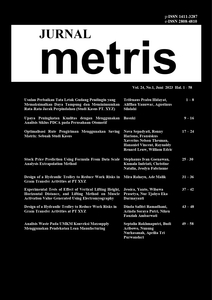Rakhmaputri, Septalia and Aribowo, Budi and Nurhasanah, Nunung and Purwandari, Aprilia Tri (2023) Analisis waste pada UMKM konveksi maxsupply menggunakan pendekatan lean manufacturing. Jurnal Metris, 24 (1). pp. 49-58. ISSN 2808-4810
|
Text (Article's Content)
ILS0325-23_Isi-Artikel.pdf - Published Version Download (613kB) |
||
![[img]](http://eprints.uai.ac.id/2390/1.hassmallThumbnailVersion/ILS0325-23_Halaman-Awal.jpg)
|
Image (Cover)
ILS0325-23_Halaman-Awal.jpg - Published Version Download (508kB) | Preview |
|
|
Text (Similarity Check)
ILS0325-23_Cek-Turnitin.pdf - Supplemental Material Download (1MB) |
Abstract
According to the theory of the Toyota Production System (TPS), there are seven types of waste that exist during the production process: Overproduction, defective products, storage, transportation, waiting, unnecessary movement, and overprocessing. To maximize profits, Maxsupply Convection uses the made-to-order production method and works to produce products according to customer requests. To meet the expectations of its customers, Maxsupply must consider productivity levels, product quality, and on-time delivery. In addition, a process can be considered efficient and effective if it does not produce waste. Meanwhile, the company's production process is inseparable from waste. The Borda method identified waste in companies and found waste in waiting and unnecessary movements. After that, a causal diagram is used to see what factors can cause waste in the production process. Man, machine, method, material, and environment cause the waiting category. Man, method, and environment cause the unnecessary movement category. Using AHP found that the highest priority cause of waste in the waiting process was due to the machine factor with a value of 10% and in the unnecessary movement category of 20% caused by environmental factors. Control recommendations given using FMEA get an RPN value of 49 with control recommendations, namely carrying out routine maintenance for machines, and an RPN value of 79 in the unnecessary movement category by implementing 5R in the production area. The proposed improvements in this study are a Standard Operating Procedure (SOP) devoted to machine routine scheduling and the implementation of 5R by all employees in the production area.
| Item Type: | Article |
|---|---|
| Uncontrolled Keywords: | AHP; FMEA; Fishbone Diagram; VSM; Borda |
| Subjects: | 300 Social sciences > 330 Economics > 338 Production, Industrial Economics 600 Applied sciences & technology > 650 Management & public relations > 658 General Management |
| Divisions: | Universitas Al-Azhar Indonesia (UAI) > Fakultas Sains dan Teknologi (FST) > Teknik Industri |
| Depositing User: | Rifda Jilan |
| Date Deposited: | 06 Oct 2023 03:36 |
| Last Modified: | 06 Oct 2023 03:36 |
| URI: | http://eprints.uai.ac.id/id/eprint/2390 |
Actions (login required)
 |
View Item |


